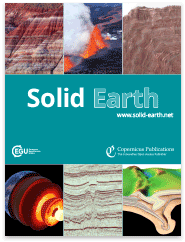Executive editors: CharLotte Krawczyk (chief executive editor), Susanne Buiter, Andrea Di Muro, Florian Fusseis, Kei Ogata & Arjen Stroeven
eISSN: SE 1869-9529, SED 1869-9537
Solid Earth (SE) is a not-for-profit journal that publishes multidisciplinary research on the composition, structure, and dynamics of the Earth from the surface to the deep interior at all spatial and temporal scales.
Journal metrics
SE is indexed in the Web of Science, Scopus, Google Scholar, etc. We refrain from displaying the journal metrics prominently on the landing page since citation metrics used in isolation do not describe importance, impact, or quality of a journal. However, these metrics can be found on the journal metrics page.
News
25 Apr 2025
15 years of Solid Earth: journal reception at EGU25
To celebrate the 15th anniversary of SE, we invite you to a reception at the EGU General Assembly 2025 in Vienna, taking place Thursday, 1 May, 18:00–19:00 at Coffee spot X3 (in front of room -2.21). We look forward to seeing you!
25 Apr 2025
15 years of Solid Earth: journal reception at EGU25
To celebrate the 15th anniversary of SE, we invite you to a reception at the EGU General Assembly 2025 in Vienna, taking place Thursday, 1 May, 18:00–19:00 at Coffee spot X3 (in front of room -2.21). We look forward to seeing you!
20 Feb 2025
Get involved, become a referee, and help shape SE's community publication output
We are pleased to announce that a new referee application form is now available. This means that if you are interested in contributing to the peer-review process and supporting high-quality scientific publishing in your community then you can apply today to become a referee. Your expertise can make a difference. Visit the online form here to learn more and join our reviewer community. 
20 Feb 2025
Get involved, become a referee, and help shape SE's community publication output
We are pleased to announce that a new referee application form is now available. This means that if you are interested in contributing to the peer-review process and supporting high-quality scientific publishing in your community then you can apply today to become a referee. Your expertise can make a difference. Visit the online form here to learn more and join our reviewer community. 
Notice on the current situation in Ukraine
To show our support for Ukraine, all fees for papers from authors (first or corresponding authors) affiliated to Ukrainian institutions are automatically waived, regardless if these papers are co-authored by scientists affiliated to Russian and/or Belarusian institutions. The only exception will be if the corresponding author or first contact (contractual partner of Copernicus) are from a Russian and/or Belarusian institution, in that case the APCs are not waived.
In accordance with current European restrictions, Copernicus Publications does not step into business relations with and issue APC-invoices (articles processing charges) to Russian and Belarusian institutions. The peer-review process and scientific exchange of our journals including preprint posting is not affected. However, these restrictions require that the first contact (contractual partner of Copernicus) has an affiliation and invoice address outside Russia or Belarus.




